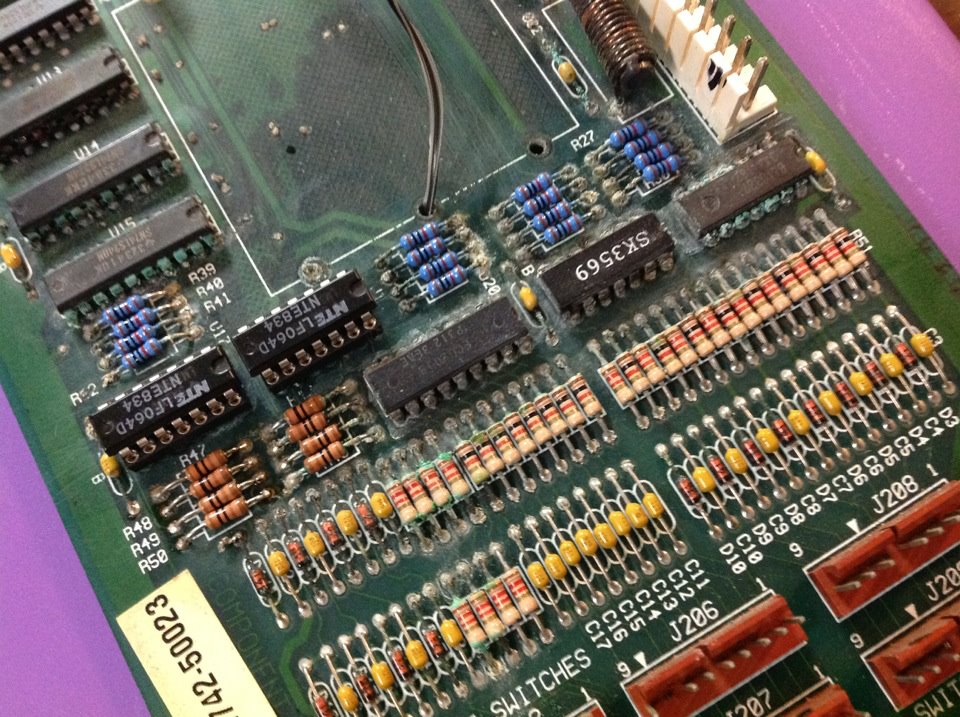I recently picked up a Funhouse as part of a trade deal I did. This game is in pretty nice shape, but it needs a little work here and there. Rudy stopped working and someone tried to “fix” it but didn’t put things back together the right way as I later found out. Here is the video series of me pulling the game apart and trying to make things work…
Monthly Archives: May 2012
Re-pinning a pinball connector (.100″ Bally/Stern MPU connectors)
In the process of working on a 70s-era, early solid-state pinball machine from Stern (MPU-100 series), I had a need to rebuild one of the connectors, so I thought I might make a video. In this case I’m re-building the smaller .100″ connector. At some point in the future I’d prefer to make a better video of this process on a bench, but unfortunately, most of the time when you’re working on these connectors, you’re huddled over the machine messing with the wiring harness.
Did you really clean that board well enough?
The other day I was reminded of how important it is to make sure you fully mitigate battery acid leakage on circuit boards. A friend picked up a STTNG (Star Trek the Next Generation) pinball machine. I’ve been systematically going over the game trying to get it working. When I first looked at the backbox I noticed wires had been run for a remote battery pack – I thought “good deal, one less thing I have to worry about.. the MPU board is clean…” so I went about working on other areas of the game, checking switches and optos and everything. After I got the game booting up I discovered the start button would not work. After spending a bunch of time testing all the wires and connectors and still not finding the culprit I took a closer look at the MPU board where the cabinet switches plug in… 
I have seen acid damage before, but nothing as sneaky and widely-spread as this. Components all across the main processing board were showing signs of corrosion and damage, but I could also see that repairs had been done, several components and ICs had been replaced and sockets added. Someone cleaned up battery damage and added an external battery pack. But there was still major corrosion on the board… what gives??
My theory is that whoever cleaned the circuit board, instead of using vinegar and multiple paper towels or q-tips, they probably used a single wipe, and in the process of cleaning the circuit board, actually spread the acid all over the components! At the time, they thought it was clean, but they actually made the problem worse.
This is why it’s very important to thoroughly clean off any leaked electrolyte from batteries, and use vinegar to neutralize it, and use multiple wipes — do not wipe from one area to another area. Work on small parts of the board at a time, throw the q-tip or paper towel away and use a clean one when you start to work on another area of the board. Do not risk spreading the acid to previously un-damaged components.
Pinball Tips: Color matching
Here’s some good advice on how to paint and touch up your game.
| Color Wanted: | Start with: | Add a little: |
|---|---|---|
| Green | Yellow | Blue |
| Orange | Yellow | Red |
| Brown | Red | Black |
| Maroon | Red | Black & Magenta |
| Cream | White | Yellow |
| Tan | White | Brown |
| Ivory | White | Yellow & Brown |
| Gray | White | Black |
| French | Gray | White Yellow & Black |
| Olive | Green | Yellow Black & White |
| Pink | White | Red |
| Flesh | White | Red & Yellow |
| Coral | White | Orange |
| Purple | Magenta | Blue |
| Gold | Yellow | Brown |
| Lime Green | Yellow | Green & White |
More hints:
- Realize that not all areas of the playfield or cabinet, even if they were painted a single color, will remain the same color over time. Different areas may fade to different shades.
- Also note that many paint colors will change slightly as they dry, or appear different if a clear coat is added later, and try to do some test runs to see how the final result will appear before committing.
- Mix your paint and put some on a piece of clear plastic and hold it over the area you’re going to touch up to see how well it matches.
- You can pick up a pantone color matching set at most hardware and paint stores and use this to help match colors.
- Don’t use hot water to clean the paint brush. This can weaken the glue that holds the bristles together and cause bristles to fall out.
- There sites online such as this one ( http://pinballpal.com/colors/ ) which has color formulas for some popular pinball games.
